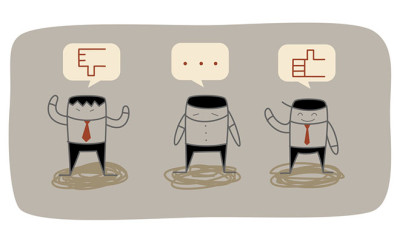
Deconstructing Feedback
Contents
1. What is feedback?
2. Six types of information to feed back
3. More distinctions
4. Three feedback techniques mapped on to the six types
5. Receiving feedback
Our purpose in writing this paper is to raise awareness of both the complexity of the feedback-giving process and the range of information that can be included in feedback. As a result we expect feedback givers to have more awareness of what is happening for them (interior) and more choice about the way the give feedback (exterior). Our hope is that this will increase the quality of feedback given and to raise the appropriateness and usefulness of the feedback process.
1. What is feedback?
Systemically speaking we cannot not respond to what others are doing, and in this respect we are always providing feedback – mostly out of awareness. However, there is also an overt and conscious kinds of feedback, which is the subject of this paper.
Although giving feedback is often portrayed as a linear process, this is an incomplete simplification. From B’s perspective, ‘giving feedback’ to A involves:

In the broadest of terms, feedback is making what is internal external, what is private public.
2. Six types of information to feed back
What goes on internally in the feedback giver can be categorised into six types of information:

What is observed (b), our personal response (c), the meaning we make (d), and our desired outcome or developmental suggestion (e) will involve either:
| Internal criteria / values / preferences | Personal: like/dislikes, standards, values, ethics. Social customs and conventions |
| or | |
| External criteria / values / preferences | The Law, assessment criteria, rules of a game, ethical standards |
Even with the most ‘objective’ of external criteria there will still be a ‘subjective’ element involved in the comparison or evaluation.
And, whether we are aware of it or not, we have probably made an assessment of the likely effects (f) of delivering our feedback.
Interestingly, our observation is that the first and last feedback types on our list – (a) frames and purpose, and (f) likely effects – are the ones feedback givers pay the least attention to, consciously that is.
Six types defined
Although in the diagram the six feedback types are shown in a linear sequence, this is not what happens in practice. Rather, a more iterative process is involved that informs itself. In general though, there is a past-present-future sequence in terms of where attention needs to go to access the information.
(a) FRAMES and purpose for the feedback
Including importance (for giver or receiver)
PAST
(b) OBSERVED behaviour
Sensory-based description of what was noticed, what was seen and heard:
– What happened
– (less frequently, what did not happen)
PAST or PRESENT
(c) Personal RESPONSE
Sensory-based, conceptual or metaphorical description of internal experience triggered by (b).
(d) MEANING given to (b) and/or (c).
Interpretation, evaluation, opinion in relation to INTERNAL or EXTERNAL criteria given in conceptual, metaphorical or numerical terms and identifying (b) or (c) as either:
– Problematic (often misleading called ‘negative’ feedback)
– Resourceful (so called ‘positive’ feedback)
– Explanation, reason, justification
FUTURE
(e) DESIRE for something to Change
Sensory-based description in relation to an INTERNAL criteria.
Description of:
– What I would like (more of) to happen (desired Outcome)
– What I would like less of/not to happen (proposed Remedy)
or
(e) DEVELOPMENTAL suggestion
sensory-based description in relation to external criteria
FURTHER FUTURE
(f) Likely EFFECTS
Consideration of effects of feedback on others
and
Sensory-based description of expected consequence if feedback:
– enacted
– somewhat enacted
– not enacted
Note: Resource, Explanation, Problem, Remedy, Outcome, Change refer to our REPROCess Model.
We appreciate these categories are useful rather than all-inclusive. The feedback giver and the feedback receiver will make these distinctions through their personalised constructs and perceptions. “To describe is also to evaluate; there is no nonevaluative description” says Stephanie Backman.* To select a behaviour, a response, an explanation or a desire is to have decided what is important and what isn’t. Every piece of feedback speaks volumes of what occupies the forefront of the giver’s attention.
* Stephanie Backman (p. 403) Epilogue: The Aesthetic Lens in On Intimate Ground: A Gestalt Approach to Working with Couples, Gordon Wheeler & Stephanie Backman (Editors). Gestalt Press, 1997.
Sample statements for each feedback type
a. FRAMES or purpose for the feedback
- I’d like to give you some feedback about …
- It’s important to me that we arrange a time for me to express my views/opinions/thoughts.
- This assessment will include feedback on when you did and when you did not meet the standard.
- You’ve met the competency standard, so what I’m going to say now is to give you a developmental stretch.
- What do you want feedback on?
- I have some comments to make on … would you like them?
- When/Where/How would you like to receive my feedback?
b. OBSERVED behaviour
- What I saw/heard was …
- I noticed you …
- When you said/did …
- I remember/recall you …
- The recording showed you …
c. Personal RESPONSE
- In response I felt/imagined/heard myself say …
- Inside it was like .
- I was …
- I was surprised by …
- I am now experiencing …
d. MEANING given to (b) and/or (c).
Internal criteria:
- Internal Criteria: I interpreted your behaviour as meaning …
- … meant I …
- My opinion is …
- In my view that was
- I did/didn’t like …
- I am now experiencing …
- Because …
- The reason I say that is …
- …. triggered … in me.
- …. resulted in …
- I would grade that a …
- I need .
- It’s important that I am .
- I appreciate that you .
- What you did (didn’t do) well was
External criteria:
- When you … you are breaking the law.
- You have demonstrated … and that meets the criteria of …
- You’ve passed your driving test.
- … is (not) company policy.
- The benchmark says …
e. DESIRE for something to Change
- I’d like to see you do …
- Please would you …
- I’d prefer you to say/do …
- Would you be willing to … ?
or
DEVELOPMENT SUGGESTION
- To demonstrate criteria … you need to .
- I need to see/hear you before you meet the standard.
- To qualify you must show you can by .
- I recommend that to … you .
F. Likely EFFECTS
- Then I will be happy.
- We will have a basis on which to work together.
- If you do not stop I shall leave the room.
- This is so important to me that should you continue with I will end our relationship.
- If there is no improvement the next stage will be a written warning.
3. More distinctions
Making use of the entire range covered by the six types of feedback will require the giver to be able to make a number of distinctions, i.e. to be able to differentiate between:
Interior (Private, Unseen) / Exterior (Public, Observable)
Description / Explanation / Interpretation / Evaluation (Opinion)
Resource / Meaning (Explanation) / Problem / Remedy / Outcome / Change
Sensory / Conceptual / Symbolic (metaphoric) description
Past / Present / Future or Before / During / After (Effects)
What (content) / How (process) / Why (two types: explaining the past or intending the future)
Levels involved in feedback
Higher
^ Frames about the feedback (a)
^
^ Meaning-making (d) and Desire/Development (e)
^
^ Response to observation (c)
^
^ Observation (b)
Lower
Ways of giving feedback
- Verbal (sensory / conceptual / metaphorical)
- Nonverbal (body / voice)
- Demonstration
What makes feedback ‘clean’?
- Asking if / when feedback wanted
- Asking how would like feedback to be delivered
- Awareness/honesty with self (especially intention)
- Making the frames and your intention overt
- Maintaining a clarity of the Frame/Purpose throughout.
- Separating the six types of feedback
- Simple, concise, straightforward delivery.
- Appropriate to the context.
- Tailored to the receiver (where possible).
4. Three feedback techniques mapped on to the six types
Common feedback techniques make use of some, but not all, of the six types of feedback given above. Below we have taken three techniques and noted which of the six types of feedback they incorporate and in what order. We notice that one of the six types (f) is not included in any of these techniques.
TABLE 1: Rosenberg’s Non-violent Communication Process

http://www.nonviolentcommunication.com/aboutnvc/4partprocess.htm

cleanlanguage.co.uk/articles/articles/272/1/Cleaning-up-the-F-word/
TABLE 3: Toastmaster’s Three R’s of Evaluation

http://www.toastmasters.org/ToastmastersMagazine/ToastmasterArchive/2007/November/The3Rs.aspx
Note: In Toastmaster’s the feedback (or ‘evaluation’ as they call it) is given to the group, not the speaker. The speaker is an observer and is referred to in the third-person.
Further reading
cleanlanguage.co.uk/articles/articles/249/1/Clean-Conversations
cleanlanguage.co.uk/articles/articles/317/1/Clean-Evaluative-Interviewing
cleanlanguage.co.uk/articles/articles/227/1/Feedback-loops
Turnbull, C. (2002) Feedback Techniques, Ashridge Learning Resource Centre Learning Guides www.ab7asy.com/Library/Management/Courses/Feedback%20techniques.pdf
5. Receiving feedback
Tips
- Say if, when, where, what, how and from whom you would like feedback
- Accept the feedback as a perfect description of the person’s internal process
- Accept they have every right to their views and opinions (even if they are ‘wrong’)
- Do not explain or justify your behaviour (unless overtly requested)
- Say: “Thank you for noticing.”
- Know it’s their stuff and “look for the boulder of truth” in yourself.
- Determine the intention of the person giving the feedback and take this into account before you ‘taking it on board’.
- Take into account the expertise of the feedback giver.
- If needs be – check your intention first – ask contextually-clean clarifying questions (see below).
Clean Clarifying Questions for Receivers of Feedback
If needed, the receiver of feedback can ask the following contextually-clean questions to fill in gaps in the six types of information provided (or not) by the giver of the feedback. These are a sample of the kind of questions that might need to be constructed by the receiver in the moment.
Frames/Purpose:
- What is your purpose in giving me this feedback?
- What would you like to have happen as a result of giving me feedback?
- And what do you anticipate the effect of giving me your feedback will be?
- Thanks for offering to give me feedback, I would rather not receive it .
- Can we arrange another time/place for the feedback?
- Where is this feedback on your scale of importance?
Observed behaviour:
- What did I do that means ?
- What did you see and hear that you are calling ?
Personal response:
- When you observe/d me , what is/was happening for you?
- What kind of ?
- Is there anything else about ?
- When you observe/d me , what is that like?
- When you observe/d me , that’s like what?
Inferred Meaning:
- When you observe/d me , what is/was happening for you?
- What kind of ?
- Is there anything else about ?
- When you observe/d me , what is that like?
- When you observe/d me , that’s like what?
Personal Desire / Other’s Development:
- What would you like to have happen?
- How would you know I was ?
- How will you know when I’m doing what you want/suggest?
Anticipated Effects:
- What happens if I do ?
- What happens if I don’t ?
- How do you know will lead to ?
Thanks are due to members of the Developing Group and in particular Phil Swallow for helping us specify the questions in this section.
First publised at cleanlanguage.co.uk







